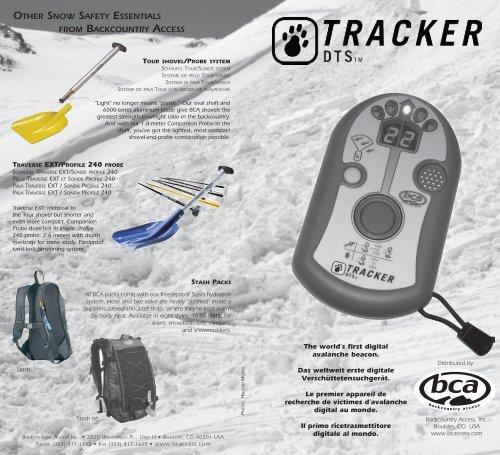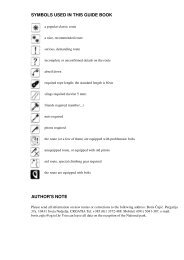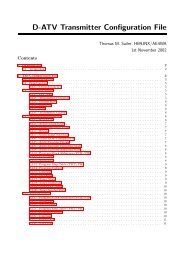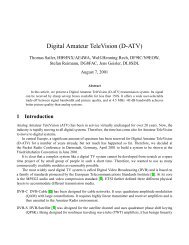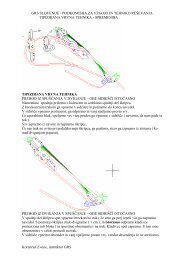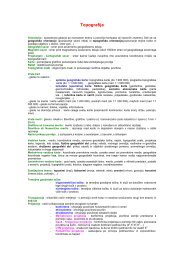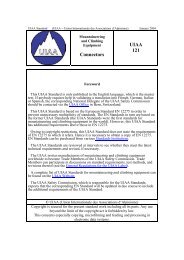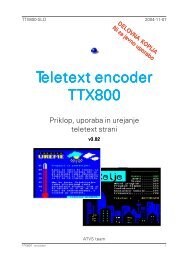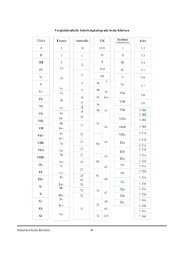other snow safety essentials from backcountry access
other snow safety essentials from backcountry access
other snow safety essentials from backcountry access
You also want an ePaper? Increase the reach of your titles
YUMPU automatically turns print PDFs into web optimized ePapers that Google loves.
OTHER SNOW SAFETY ESSENTIALS<br />
FROM BACKCOUNTRY ACCESS<br />
TOUR SHOVEL/PROBE SYSTEM<br />
SCHAUFEL TOUR/SONDE SYSTEM<br />
SYSTEME DE PELLE TOUR/SONDE<br />
SISTEMA DI PALA TOUR/SONDA<br />
SISTEMA DE PALA TOUR CON SONDA DE AVALANCHAS<br />
"Light" no longer means "plastic." Our oval shaft and<br />
6000-series aluminum blade give BCA shovels the<br />
greatest strength-to-weight ratio in the <strong>backcountry</strong>.<br />
And with our 1.8-meter Companion Probe in the<br />
shaft, you've got the lightest, most compact<br />
shovel-and-probe combination possible.<br />
TRAVERSE EXT/PROFILE 240 PROBE<br />
SCHAUFEL TRAVERSE EXT/SONDE PROFILE 240<br />
PELLE TRAVERSE EXT ET SONDE PROFILE 240<br />
PALA TRAVERSE EXT / SONDA PROFILE 240<br />
PALA TRAVERSE EXT / SONDA PROFILE 240<br />
Traverse EXT: identical to<br />
the Tour shovel but shorter and<br />
even more compact. Companion<br />
Probe does not fit inside. Profile<br />
240 probe: 2.4 meters with depth<br />
markings for <strong>snow</strong> study. Foolproof<br />
twist-lock tensioning system.<br />
STASH PACKS<br />
All BCA packs come with our freezeproof Stash hydration<br />
system. Hose and bite valve are neatly "stashed" inside a<br />
superinsulateed shoulder strap, where they're kept warm<br />
by body heat. Available in eight styles, 16-55 liters, for<br />
skiers, <strong>snow</strong>boarders, climbers,<br />
and <strong>snow</strong>mobilers.<br />
The world's first digital<br />
avalanche beacon.<br />
Stash<br />
Stash bc<br />
BACKCOUNTRY ACCESS INC. • 2820 WILDERNESS PL., UNIT H • BOULDER, CO 80301 USA<br />
PHONE (303) 417-1345 • FAX (303) 417-1625 • www.bc<strong>access</strong>.com<br />
PHOTO: HALSTED MORRIS<br />
Das weltweit erste digitale<br />
Verschüttetensuchgerät.<br />
Le premier appareil de<br />
recherche de victimes d’avalanche<br />
digital au monde.<br />
Il primo ricetrasmettitore<br />
digitale al mondo.<br />
Distributed by:<br />
Backcountry Access, Inc.<br />
Boulder, CO USA<br />
www.bc<strong>access</strong>.com
OPERATING ELEMENTS<br />
BEDIENUNGSELEMENTE<br />
FONCTIONNEMENT ET AFFICHAGE<br />
COMPONENTI<br />
ELEMENTOS DE USO<br />
Warranty Information<br />
Limited Warranty<br />
Rescue Technology, the manufacturer, expressly warrants the workmanship<br />
and components of the Tracker DTS for five years after the<br />
date of retail purchase. All parts will be either repaired or replaced free<br />
of charge, including labor, by the manufacturer. This warranty does not<br />
cover damage to the product caused by improper use or excessive wear<br />
and tear. Direct all warranty claims to your retailer or distributor. Direction All claims Lights<br />
must include proof of purchase and a return authorization Richtungsanzeige<br />
number. To<br />
Affichage de la direction<br />
ensure warranty protection, please return the enclosed warranty registration<br />
card.<br />
Spie luminose di direzione<br />
Luces direccionales<br />
Options Button<br />
Optionenschalter<br />
Bouton options<br />
Pulsante opzioni<br />
Boton de opciones<br />
6<br />
Garantiebeschränkung<br />
Distance Indicator/Battery Power Display<br />
Der Distanzanzeige/Batterieladungsanzeig<br />
Hersteller Rescue Technology, garantiert während fünf Jahren<br />
Indicateur ab Kaufdatum de distance/Témoin für Verarbeitungs de und batterie Materialfehler. Alle Teile werden<br />
Indicatore repariert di distanza/Display oder durch den del Hersteller livello batteria gratis ersetzt. Die Garantie erstreckt<br />
sich Indicator nicht auf de distancia/Estado Schäden durch Abnützung de bateriaoder fehlerhafte Bedienung. Alle<br />
Garantieansprüche sind zu richten an die Verkaufstelle oder an die jeweilige<br />
Landesvertretung.<br />
Loudspeaker<br />
Lautsprecher<br />
Haut-parleur<br />
Altoparlante<br />
Garantie<br />
Le fabricant, Rescue Technology, garantit le Tracker DTS trois ans<br />
Altavoz<br />
pièces et main d'oeuvre à partir de la date d'achat. Toute pièce sera<br />
réparée ou remplacée gratuitement, main d'oeuvre comprise, par le fabricant.<br />
Cette garantie ne couvre pas les dégâts résultants d'une mauvaise<br />
utilisation. Toute réclamation devra être adressée à votre détaillant ou<br />
distributeur. Toute réclamation devra Search/Transmit être accompagnée Button de la preuve<br />
Sende-/Empfangsschalter<br />
d'achat et d'un numéro de SAV.<br />
Sélecteur mode recherche/émission<br />
Pulsante ricerca/trasmissione<br />
Limitazioni della Garanzia Boton de busqueda/transmisión<br />
Il costruttore, Rescue Technology, garantisce espressamente la corretta<br />
costruzione ed i componenti del Tracker DTS per tre anni dalla data<br />
di acquisto presso il dettagliante. Le parti saranno riparate o sostituite<br />
gratuitamente - ore di manodopera incluse - presso il costruttore. La presente<br />
garanzia non copre Transmit i danni Light al prodotto derivanti da uso improprio,<br />
usura eccessiva o Sendekontrolllampe<br />
squarcio. Inviate qualsiasi richiesta di intervento in<br />
garanzia al vostro dettagliante Témoin d’émission o distributore. Tutte le richieste devono<br />
comprendere Spia luminosa una prova di di trasmissione acquisto e lo specifico numero di autorizzazione.<br />
Indicador de transmisión<br />
Lanyard<br />
Fangschnur<br />
Lanière<br />
Lacciolo<br />
Acollador<br />
8<br />
Garantía Limitada<br />
El fabricante, Rescue Technology, garantia la fabricanción y los<br />
componentes del Tracker DTS por un período de tres años a partir de<br />
la fecha de compra. El fabricante se compromete a reparar o cambiar<br />
todas las piezas sin costo, incluyendo la mano de obra. Esta garantia<br />
no cubre los daños causados por el uso inadecusdo o desgaste excesivo.<br />
Todas las reclamaciones deberán incluir la prueba de compra así<br />
como el número de autorización de devolución.
Quick Reference<br />
Rescue Technology, Inc.<br />
Model No.: Tracker DTS<br />
FCC ID:<br />
OUNDTS1<br />
This device complies with part 15 of the FCC Rules.<br />
Operation is subject to the following two conditions:<br />
(1) This device may not cause harmful interference, and<br />
(2) this device must accept any interference received, including<br />
interference that may cause undesired operation.<br />
This quick reference page is an introduction to proper use of the Tracker<br />
DTS. For more detailed information, read the entire manual and consult<br />
our website: www.bc<strong>access</strong>.com.<br />
Basic functions<br />
On/off -- Push and turn the on/off switch on the back of the<br />
Tracker to the "on" position. It performs a self-diagnostic check,<br />
displays battery power in percent, and enters transmit mode.<br />
Change batteries before they reach zero percent.<br />
Search mode -- Push the red search/transmit button, hold until<br />
"SE" is displayed, then quickly release.<br />
ENGLISH<br />
Note:<br />
This equipment has been tested and found to comply with the limits for a<br />
Class B digital device, pursuant to part 15 of the FCC Rules. These<br />
limits are designed to provide reasonable protection against harmful<br />
interference in a residential installation. This equipment generates,<br />
uses and can radiate radio frequency energy and, if not installed and<br />
used in accordance with the instructions, may cause harmful interference<br />
to radio communications. However, there is no guarantee that<br />
interference will not occur in a particular installation. If this<br />
equipment does cause harmful interference to radio or television<br />
reception, which can be determined by turning the equipment off and on,<br />
the user is encouraged to try to correct the interference by one or more<br />
of the following measures:<br />
• Reorient or relocate the receiving antenna.<br />
• Increase the separation between the equipment and receiver.<br />
• Connect the equipment into an outlet on a circuit different <strong>from</strong> that<br />
to which the receiver is connected.<br />
• Consult the dealer or an experienced radio/TV technician for help.<br />
Caution:<br />
Any changes or modifications not expressly approved by the party<br />
responsible for compliance could void the user’s authority to operate<br />
this device.<br />
Designed, assembled and tested in the USA.<br />
Return to transmit -- Press the search/transmit button until "tr"<br />
is displayed.<br />
Searching with the Tracker DTS<br />
The objective for beginners is to find the strongest signal (lowest<br />
distance reading) and immediately begin probing the area.<br />
In the event of a burial, switch your Tracker (and all <strong>other</strong> beacons)<br />
to search mode. "SE" will flash in the distance window<br />
until a signal is captured.<br />
Primary/signal search: If there is a "last seen point," start your<br />
signal search there, and search downhill. Otherwise, start your<br />
signal search at the top of the slide path. Allow a maximum of 20<br />
meters between searchers or between switchbacks if only one<br />
searcher. Slowly rotate your Tracker back and forth and vertically<br />
until you engage the signal.<br />
Secondary search: Once a signal is engaged, align the Tracker<br />
so that any of the center three lights are flashing and move<br />
quickly in the direction the Tracker is pointing. Your direction of<br />
travel might be straight or slightly curved. Make sure the number<br />
in the distance display is decreasing. If it is increasing, turn 180<br />
degrees. Inside ten meters, move slowly and try to keep the center<br />
search light engaged.<br />
Pinpoint search: Within three meters, use your beacon close<br />
to the <strong>snow</strong> surface and look for the smallest distance reading.<br />
Ignore sudden fluctuations in distance and direction; the<br />
strongest signal is often just past these fluctuation points. Begin<br />
probing at the smallest reading (strongest signal).<br />
4<br />
5
Quick Reference<br />
Familiarization<br />
PRIMARY<br />
SEARCH<br />
>40m<br />
SECONDARY<br />
SEARCH<br />
3–40m<br />
PINPOINT<br />
SEARCH<br />
< 3m<br />
Single Burial Search<br />
Objective: Locate signal<br />
•If no "last seen point," search entire debris pile<br />
•Rotate Tracker horizontally/vertically<br />
•Max 20m between searchers or switchbacks<br />
Objective: Move quickly to 10m,<br />
slowly to 3m<br />
•Keep flashing light within center 3 windows<br />
•Move quickly in direction Tracker is pointing<br />
•Make sure distance is decreasing<br />
•Slow down at 10m<br />
Objective: Locate smallest distance reading<br />
(strongest signal)<br />
•Use Tracker close to <strong>snow</strong> surface<br />
•Ignore fluctuations in distance and direction<br />
•Begin probing at lowest distance<br />
•Use Tracker in hole during deep excavations<br />
Multiple Burial Search<br />
If the Tracker displays more than one signal, follow the one<br />
with the lowest distance reading. Once you are within about ten<br />
meters, the Tracker will isolate that signal. Turn off the first beacon<br />
once it is found. If you can’t turn it off, and don’t see a second<br />
signal, stay in SE mode. Take three steps back and circle the first<br />
victim. Repeat up to three times (nine steps). If no signal is found,<br />
return to the point at which you abandoned the primary search<br />
and continue the search <strong>from</strong> there. For advanced multiple burial<br />
searching, read the entire manual or see our website.<br />
Thank you for choosing the Tracker DTS, the world's first<br />
digital avalanche beacon, and the first beacon with a highprecision<br />
dual antenna system. Regardless of the transceiver,<br />
no avalanche beacon can save lives without a fully trained<br />
user. Practice frequently with your Tracker before going into<br />
the <strong>backcountry</strong>. Learn and understand the inherent dangers<br />
of <strong>backcountry</strong> travel. Become educated in avalanche hazard<br />
evaluation, route selection, and self-rescue. Always carry an<br />
avalanche beacon, probe, and shovel—and always travel with<br />
a partner.<br />
Make sure all rescue equipment is functioning properly before<br />
venturing into the <strong>backcountry</strong>. Perform a beacon trailhead test<br />
every time you use your Tracker. Check that all transceivers<br />
transmit and receive properly—and that all receive a signal at<br />
minimum distance of ten meters.<br />
This owner’s manual covers the basic techniques required to<br />
use the Tracker DTS effectively. To increase your efficiency,<br />
please refer to the advanced techniques described on our<br />
website: www.bc<strong>access</strong>.com. Here you will also find important<br />
resources for obtaining avalanche education and updates on<br />
regional avalanche conditions.<br />
To ensure warranty protection and periodic technical updates,<br />
please return the enclosed warranty registration card.<br />
FAMILIARIZATION<br />
Adjustment/Fitting<br />
Figure A Harness<br />
ENGLISH<br />
<br />
<br />
Shoulder<br />
Strap<br />
<br />
(grey)<br />
<br />
<br />
<br />
6<br />
DAV Safety Research<br />
<br />
<br />
<br />
Waist Strap<br />
<br />
(black)<br />
Lanyard<br />
Waist Attachment<br />
Buckle <br />
7
Familiarization<br />
Familiarization<br />
The Tracker DTS can be worn with or without its harness. The<br />
manufacturer recommends securing it with the harness.<br />
When worn with a harness, the Tracker DTS should be worn<br />
underneath your outer garments, as shown in Figure A. The<br />
concave side should be snug against your lower left rib cage.<br />
To search, remove Tracker <strong>from</strong> pouch, but keep lanyard<br />
attached to your body. If using without harness, keep Tracker in<br />
a secure pocket, preferably in your pants or <strong>other</strong> garment that<br />
won't be removed. When searching, secure Tracker to your wrist<br />
with the lanyard.<br />
Startup/Testing<br />
Turn on the Tracker DTS by depressing and then turning the on/<br />
off switch (1) clockwise (see inside front cover). When turned on,<br />
the Tracker runs through a brief diagnostic test of all LED's, then<br />
indicates the remaining battery life in the battery power display/<br />
distance indicator (2). A reading of 95 to 99 percent indicates<br />
fully charged batteries. After the diagnostics, the Tracker will<br />
enter transmit mode (tr). The flashing transmit light (3) confirms<br />
the unit is in transmit mode.<br />
Power Supply<br />
The Tracker DTS operates with three AAA alkaline batteries. Use<br />
only high-quality alkaline batteries of identical age and brand. Do<br />
not use rechargeables.<br />
Note that the battery level percentage is approximate, depending<br />
on battery manufacturer and operating temperature. The Tracker<br />
will operate safely down to and below a zero battery power display.<br />
The manufacturer suggests, however, that you replace your<br />
batteries frequently, well before this occurs.<br />
If the Tracker is subjected to excessive moisture, open the battery<br />
door (4) to help allow the unit to dry. To prevent corrosion of<br />
contacts, remove batteries during extended periods of inactivity.<br />
Search/Transmit<br />
To enter search mode, push the search/transmit button (5) for<br />
at least one second, but for no longer than two seconds. During<br />
this time, the distance indicator (2) will display two dashes<br />
(“– –”). Release your thumb when the display changes <strong>from</strong><br />
“– –” to “SE” and the Tracker sounds a series of three beeps.<br />
If the button is released before or after this time, it will remain in<br />
transmit mode.<br />
8<br />
The Tracker can be switched instantly <strong>from</strong> search (SE) to<br />
transmit (tr) mode at any time by simply pushing the search/<br />
transmit button.<br />
Options<br />
Auto-Revert System<br />
At startup, the user can engage the Tracker’s auto-revert <strong>safety</strong><br />
feature by pressing the options button (6) while pressing and<br />
turning the on/off switch. With auto-revert engaged, the Tracker<br />
will revert to transmit mode after five minutes in search mode.<br />
If auto-revert is engaged, “Ar” will be shown in the power display<br />
after the diagnostic testing. If auto-revert is not engaged, “nr” will<br />
be displayed.<br />
If auto-revert has been engaged, then after five minutes in<br />
search mode, an alarm will sound for ten seconds and "Ar" will<br />
flash repeatedly in the distance indicator. To remain in search<br />
mode, press the search/transmit button or the options button<br />
at any time during the ten-second alarm period. If ten seconds<br />
elapses, “tr” will appear and the Tracker will revert to transmit<br />
mode.<br />
If auto-revert is not engaged, the Tracker will sound a short<br />
alarm every ten minutes to remind the user that he or she is in<br />
search mode.<br />
Special Mode<br />
Special (SP) mode is a feature designed to assist searchers<br />
in the event of a multiple burial. It can help searchers isolate<br />
individual signals when searching for more than one transmitter<br />
at a time. In search (SE) mode, the Tracker only displays<br />
the strongest signal (once the searcher is within about teen<br />
meters). In special (SP) mode, however, it will display all signals,<br />
regardless of their strength—providing they are within special<br />
mode’s reduced search window (Figure E, page 11). In special<br />
mode, the search area is reduced <strong>from</strong> 180 degrees—front and<br />
back—to about 75 degrees: signals will only be displayed if they<br />
are captured within the center three directional lights.<br />
Special mode can only be entered while the user is in search<br />
mode. To enter SP mode, press the options button (6). Release<br />
the button when "SP" appears in the display window. When<br />
signals are detected in this mode, they are displayed for a<br />
shorter time than in SE mode.<br />
9<br />
ENGLISH
OPTIONS<br />
D<br />
%<br />
a t<br />
S<br />
E<br />
A<br />
R<br />
C<br />
H<br />
st a rt<br />
u p<br />
TRANSMIT<br />
Operating Instructions<br />
Operating Instructions<br />
Mute Mode<br />
To mute the sound while in search mode, push the options button<br />
(6) for three seconds until “LO” is displayed, then release. To<br />
turn the speaker back on, perform the same operation. “L1” will<br />
be displayed, indicating the speaker is back on.<br />
OPERATING INSTRUCTIONS<br />
Searching<br />
The Tracker DTS operates using the 457 kHz international<br />
standard frequency. It is fully compatible with all avalanche<br />
transceivers adhering to this standard. Do not use with 457kHz<br />
transceivers designed for firefighter rescue.<br />
The search process includes three phases: the signal (or primary)<br />
search, the fine (or secondary) search, and the pinpoint<br />
search.<br />
Signal/Primary Search<br />
The signal search refers to the process of establishing a search<br />
pattern and looking for a signal. The search pattern will be<br />
defined by the victim’s last seen area, the size of the slide, and<br />
the number of searchers. Refer to Figures B and C, below, to<br />
establish a primary search pattern. If the slide is less than 20<br />
meters wide, the primary search path will be directly down the<br />
center. If the victim’s last seen area is well defined, the primary<br />
search will follow a direct path down the fall line <strong>from</strong> this point.<br />
10<br />
Figure B Primary Search<br />
One searcher/Slide wider than 20 meters<br />
10m<br />
10m<br />
Area last seen<br />
20m<br />
20m<br />
20m<br />
10m<br />
Figure C Primary Search<br />
Multiple searchers/Slide wider than 20 meters<br />
10m<br />
Area last seen<br />
20m<br />
20m<br />
10m<br />
Direction<br />
of search<br />
path<br />
Figure D<br />
Primary/Signal search<br />
Rotate the Tracker slowly<br />
in your hand, but move<br />
rapidly down the search<br />
path. Do not abandon<br />
your search path until you<br />
have captured a strong,<br />
steady signal. Ignore irregular<br />
signals, which can<br />
sometimes be caused by<br />
electrical interference.<br />
Prior to the primary search, be sure that all transceivers are<br />
turned to search mode. Rotate the Tracker slowly back and forth<br />
on a horizontal and vertical plane (Figure D) while moving in<br />
the direction as defined by your primary search pattern. While<br />
searching, be aware of <strong>other</strong> physical clues, such as equipment<br />
or extremities protruding <strong>from</strong> the <strong>snow</strong> surface. When no signal<br />
is detected, “SE” will flash in the distance indicator. Once a<br />
signal is detected consistently, mark this spot and begin the fine<br />
search.<br />
Secondary/Fine Search<br />
The secondary search (also referred to as the fine search) is the<br />
portion of the search <strong>from</strong> where you have detected a steady<br />
signal to where you are close to the victim.<br />
Once the signal is consistently detected, rotate the Tracker<br />
slowly on a horizontal plane until the center direction light (7)<br />
is blinking. The Tracker is now pointed in the direction of the<br />
strongest signal, or your direction of travel (Figure E). The four<br />
lights (7) on either side of center tell you which way to rotate<br />
the Tracker to engage the center light. The distance indicator<br />
Figure E<br />
Windows<br />
The Tracker is very sensitive. Slight<br />
movement in any direction will actuate<br />
a different search light. Rotate it<br />
very slowly so as not to “skip” over<br />
the center search light window.<br />
In special (SP) mode, signals<br />
are only displayed if they fall<br />
within the center three<br />
windows.<br />
Direction of<br />
strongest signal<br />
B a tt e r y<br />
I S T A N C E<br />
11<br />
ENGLISH
Operating Instructions<br />
Operating Instructions<br />
(2) tells you, in approximate meters, how far you must travel<br />
(1 meter = 1.1 yards or 3.3 feet). If the number on the distance<br />
indicator is increasing, you are on the same axis as the victim’s<br />
signal, but moving in the opposite direction. Turn 180 degrees,<br />
engage the center search light again, and continue your search<br />
in the direction the Tracker is pointing. This is preferable to walking<br />
backwards, in which case the Tracker will often flash “SE”<br />
rather than show a direction and distance. If you are stationary,<br />
but the distance is significantly changing, you are probably<br />
detecting the signal of an<strong>other</strong> rescuer. Make sure all rescuers<br />
are in search mode before continuing.<br />
Move your beacon very slowly along the surface of the <strong>snow</strong><br />
during the final three meters of the pinpoint search. It can be<br />
helpful to tilt the front of the Tracker down, although it is not<br />
necessary. Ignore sudden fluctuations in distance and direction,<br />
often followed by no distance reading and/or "SE" in the<br />
distance indicator. This means you are very close. The lowest<br />
reading will be near this point.<br />
Figure G<br />
Pinpoint Search<br />
Bird’s-eye<br />
view<br />
ENGLISH<br />
Figure F<br />
Flux lines<br />
You may find that, while following the directional lights, your<br />
route follows an arc. This is because the Tracker DTS performs<br />
the fine search using the "flux (or induction) line" method (see<br />
Figure F). It follows the shape of the electromagnetic signal, or<br />
flux line pattern, coming <strong>from</strong> the transmitting beacon’s antenna.<br />
The distance displayed is the distance to be traveled along that<br />
flux line, not the straight-line distance <strong>from</strong> you to the victim.<br />
Pinpoint Search<br />
The pinpoint search is the final part of the beacon search, which<br />
is performed on foot with the beacon positioned at or near the<br />
<strong>snow</strong> surface. The objective of the pinpoint search is to locate<br />
where the signal is strongest and to reduce the area to be<br />
probed.<br />
12<br />
The Tracker follows the shape<br />
of the electromagnetic flux<br />
lines coming <strong>from</strong> the transmitting<br />
beacon’s antenna.<br />
Your path during the fine<br />
search will be either<br />
straight (point A)<br />
or curved (point B),<br />
depending on the<br />
orientation of your<br />
beacon when the<br />
signal is first captured.<br />
Note: the Tracker’s transmitting<br />
antenna (10) is oriented<br />
at a 45-degree angle to the<br />
long axis of its case,<br />
as shown.<br />
Cross-section<br />
view<br />
Transmitting Beacon<br />
Bracketing: From the point where you have located the smallest<br />
reading, it can be helpful to "bracket" at 90-degree angles to the left<br />
and then to the right in search of a lower reading (bird’s-eye view).<br />
Pinpointing on a line: You will encounter a “spike” reading where<br />
the vertical aspect of the flux pattern is perpendicular to the searching<br />
beacon (cross-section view). This is indicated by a suddenly<br />
weaker signal (higher distance reading) and fluctuations or loss of<br />
directional lights, and/or “SE” in the display. Search past the spike for<br />
a lower distance reading along the line you’ve been travelling. If you<br />
do not deviate <strong>from</strong> this line, it is not necessary to bracket.<br />
From the point where you have located the smallest reading, it<br />
can be helpful to "bracket" at 90-degree angles to the left and<br />
then to the right in search of a lower reading (Figure G, bird’seye<br />
view). Repeat if necessary along both axes. Begin probing<br />
at the lowest distance reading, in an expanding spiral pattern.<br />
ADVANCED TECHNIQUE: PINPOINTING ON A LINE<br />
Until the Tracker is very close, it will point you in the general<br />
direction of the buried beacon. Once you are within less than<br />
13
Operating Instructions<br />
Operating Instructions<br />
approximately three meters, however, there is a "spike" reading<br />
where the distance and direction lights fluctuate and the distance<br />
display might flash "SE". At this point, the searching Tracker is<br />
temporarily perpendicular to the vertical aspect of the flux pattern<br />
of the buried beacon (Figure G, cross-section view). If you<br />
draw a line in the <strong>snow</strong> or place a long object on the <strong>snow</strong> in<br />
the direction you were pointing just before the spike, you can<br />
limit your pinpoint search to that line. Known as "pinpointing on<br />
a line," this technique performed properly is the most efficient<br />
method for pinpointing with the Tracker.<br />
In most cases, the buried beacon will be oriented roughly horizontal,<br />
there will be two “spikes,” and the lowest reading will<br />
be between them, as shown in Figure G. If the transmitter is<br />
buried vertically, there will be only one spike and a low reading<br />
on either side. In either case, probe at the lowest reading along<br />
the flux line.<br />
Probing/Digging<br />
At the point where the distance has reached a minimum, probe<br />
the area. Your probe should enter the <strong>snow</strong> perpendicular to the<br />
slope surface. Once you have confirmed the victim’s location,<br />
leave the probe in the <strong>snow</strong> and begin digging. To monitor your<br />
progress during a deeper burial, continue to use the Tracker<br />
inside the hole. Upon reaching the victim, first uncover his or her<br />
face. In the event of multiple burials, turn off the victim's beacon<br />
(if possible) before continuing the search for the next victim.<br />
Multiple Burials<br />
Multiple beacon searches are more difficult and complex than<br />
single searches. They require practice and an understanding of<br />
flux lines. A thorough understanding of the Tracker’s special (SP)<br />
mode can also greatly increase the efficiency of the multiple<br />
search, though it is not necessary.<br />
If you begin to receive more than one set of signal data, you<br />
probably have a multiple burial. Stay in search (SE) mode, and<br />
focus on the closest distance reading, attempting to engage that<br />
signal in the center search light. If you are roughly the same distance<br />
<strong>from</strong> both transmitters, the Tracker will often flash “SE”.<br />
14<br />
Once you are significantly closer to one signal—and within about<br />
ten meters of it—the Tracker DTS (in SE mode) will “lock” onto<br />
that signal and mask out the <strong>other</strong>s. Once you are locked in, the<br />
Tracker will behave very similar to how it does in a single beacon<br />
search. Pay attention to the readings you last received <strong>from</strong><br />
the <strong>other</strong> beacon; they will give you an indication of where to go<br />
after finding the closest one.<br />
Once you have located the first beacon (beacon 1), turn it off.<br />
If this is not possible, you might already have a good idea of<br />
where beacon 2 is located. In that case, move in that direction<br />
until the Tracker isolates that signal. If you do not have an idea<br />
of where to look next, then remain in SE mode and take three<br />
steps away <strong>from</strong> the found victim. Walk in a circle of this radius<br />
around the victim, attempting to acquire an<strong>other</strong> signal in SE<br />
mode. If no signal is acquired, take an<strong>other</strong> three steps back<br />
and repeat up to a maximum of three circles (nine steps). If a<br />
new signal is acquired, pinpoint by bracketing. If no signal is<br />
acquired, return to the point where you abandoned the primary<br />
search and continue the search (in SE mode) <strong>from</strong> there.<br />
ADVANCED TECHNIQUE: SPECIAL MODE<br />
For greater efficiency in multiple burials—especially when victims<br />
are close together—use special (SP) mode. This mode<br />
enables the Tracker to display the distance and direction of signals<br />
<strong>other</strong> than those of the closest beacon. It also reduces the<br />
Tracker’s search “window” to the center three directional lights,<br />
enabling the searcher to mask out beacon 1 and differentiate<br />
<br />
<br />
DAV Safety Research<br />
<br />
<br />
<br />
<br />
<br />
<br />
<br />
<br />
<br />
<br />
<br />
<br />
15<br />
ENGLISH
Operating Instructions<br />
Operating Instructions<br />
it <strong>from</strong> beacon 2. SP mode is used to determine approximately<br />
what direction and distance to go to get closer to beacon 2.<br />
Once you are closer, always switch back to SE mode.<br />
At the lowest possible distance reading, re-engage beacon 1 in<br />
your center search light. With the center search light engaged,<br />
switch the Tracker to SP mode (Figure I). Then rotate—do not<br />
sweep—the Tracker slowly until an<strong>other</strong> signal is detected (beacon<br />
2), most likely with a larger distance reading. If the Tracker<br />
is rotated more than about 40 degrees away <strong>from</strong> the flux line of<br />
beacon 1, that signal will disappear, allowing you to focus on the<br />
signal <strong>from</strong> beacon 2. This “filtering” process can often simplify<br />
multiple searches.<br />
If no <strong>other</strong> signal is captured in SP mode,stand up and try again<br />
at chest height. If still no <strong>other</strong> signal is detected, take three<br />
steps back and repeat.<br />
Figure I<br />
Multiple burials/<br />
Special mode<br />
Only travel far enough in<br />
SP mode to confirm the<br />
distance is decreasing and<br />
which way the flux line is<br />
trending. At this point, a<br />
good rule of thumb is to<br />
ignore further readings and<br />
swiftly travel at least 3/4 of<br />
the distance displayed. Then<br />
lock in beacon 2 by switching<br />
back to search mode.<br />
Once you have located an<strong>other</strong> signal, begin to move in that<br />
direction. If the distance consistently decreases, you are going<br />
in the right direction. Travel far enough in SP mode to confirm<br />
the distance is decreasing and which way the flux line is trending.<br />
If the flux line is curving sharply, continue in SP mode until<br />
it becomes straighter. If more than one signal is being displayed<br />
and it becomes unclear which one to pursue, continue in the<br />
direction you have been searching. Always switch back to SE<br />
mode when you think you are getting closer to beacon 2 than<br />
beacon 1.<br />
<br />
<br />
Revert to search mode and perform a primary search of the<br />
remaining unchecked areas within the debris pile. Resume your<br />
primary search at the point where it was originally abandoned.<br />
Three or more victims<br />
If more than two beacons are buried, multiple burials become<br />
extremely complex with any transceiver, especially if the beacons<br />
are very close together.<br />
Primary search<br />
If the searcher has reason to believe there are several signals in<br />
close proximity to each <strong>other</strong>, it can be very effective to reduce<br />
the search strip width accordingly, <strong>from</strong> 20 meters to less than<br />
5 meters.<br />
Secondary search<br />
In close-proximity situations, it is important to go into SP mode<br />
as close as possible to the found beacon. This will create a<br />
more noticeable difference in the distance readings for each<br />
transmitter. Place the Tracker, as close as possible to the <strong>snow</strong><br />
surface. Avoid entering SP mode at the spike signal.<br />
In situations where many beacons are buried all within a small<br />
area, it can be difficult to "pinpoint on a line." This is because<br />
you will be starting the search for each beacon <strong>from</strong> a very close<br />
distance; therefore the flux lines will probably be curved and<br />
overlapping. Often it is simpler to pinpoint using the bracketing<br />
method.<br />
For more details on multiple burials, please refer to our website:<br />
www.bc<strong>access</strong>.com.<br />
ENGLISH<br />
If after finding a victim, no further signals are detected in SP<br />
mode, continue the search if there are still missing victims.<br />
16 17
Technical Information<br />
Kurzreferenz<br />
TECHNICAL SPECIFICATIONS<br />
• Frequency: 457 kHz<br />
• Batteries: Three AAA/LR03 alkaline batteries; do not use rechargeables.<br />
• Battery life: minimum 1 hour in search mode after 200 hours in transmit<br />
mode (approximately 250 hours in transmit only or 50 hours in search<br />
only)<br />
• Receive range: up to 50 meters (with Tracker DTS transmitting)<br />
• Weight: 12.8 ounces (363 grams), including strap and batteries; 8.6<br />
ounces (245 grams) without strap and batteries<br />
• Size: 5-3/4” x 3-1/4” x 1-1/4” (14cm x 8cm x 3cm)<br />
• Minimum temperature range (at 66.7 percent battery power):<br />
transmit mode: -10°C to +40°C (14°F to 104°F);<br />
search mode: -20°C to +40°C (-4°F to 104°F)<br />
• U.S. Patent number 6,167,249 & 6,484,021 B1<br />
Do not place cellular phones, communication radios, or any <strong>other</strong> electronic<br />
equipment within 6" (15 cm) of the Tracker DTS while performing a transceiver<br />
search. In receive mode, irregular readings and decreased range<br />
can be caused by these and <strong>other</strong> sources of electrical interference, such<br />
as power lines, electrical storms, and electrical generating equipment. In<br />
transmit mode, the Tracker DTS can tolerate equipment touching end-to-end<br />
or as close as 1" (2.5 cm) if stacked horizontally.<br />
Conforms to the R&TTE harmonized version of the EN 300 718 and meets<br />
or exceeds the requirements of Articles 3.1, 3.2, and 3.3.<br />
FCC ID: OUNDTS1<br />
CANADA: 35811021823<br />
Grundfunktionen<br />
On/off: Drücken Sie und drehen Sie den on/off Schalter auf der<br />
Rückseite des Trackers in Position „on". Es folgt ein Selbstcheck<br />
, der Batteriefüllstand in % wird angezeigt (99 – 95 % = volle<br />
Batterien). Tauschen Sie die Batterien bevor Sie 0 % erreichen.<br />
Empfehlung bei ca 20 %. Nach dem Selbsttest wechselt der Tracker<br />
mit der Anzeige „tr" („transmit" = „senden") in den Sendemodus. Von<br />
nun an blinkt die Sendekontrolllampe (3).<br />
Schalten in den Suchmodus: Drücken Sie den roten Knopf bis<br />
„SE" im Display aufscheint, nach „SE" sofort loslassen.<br />
Rückschalten in den Sendemodus: Kurzes drücken des roten<br />
Knopfes, „tr" für transmit (senden) im Display. Sendekontrolle (3)<br />
blinkt.<br />
Die Suche mit dem Tracker DTS<br />
Das Ziel für Einsteiger ist es, den Punkt der geringsten Entfernung zu<br />
finden und dort mit der Sondierung zu beginnen.<br />
Schalten Sie Ihren Tracker (und alle anderen Geräte!!!) in den<br />
Suchmodus (SE). Bis zum Empfang eines Signals blinkt „SE"<br />
(„search" = „suchen") im Display.<br />
Primärsuche: Gibt es einen „Verschwindepunkt" starten Sie Ihre<br />
Signalsuche abwärts von diesem Punkt.<br />
Bestimmen Sie Ihr Suchmuster abhängig von der Anzahl der zur<br />
Verfügung stehenden Personen (Abb. B + C). Schwenken Sie den<br />
Tracker horizontal und vertikal. (Abb. D)<br />
Grobsuche: Empfangen Sie ein Signal, drehen Sie sich mit dem<br />
Tracker bis die Mittelleuchte (Pfeil) zentriert ist. Bewegen Sie sich<br />
zügig in die vom Tracker angezeigte Richtung. Beobachten Sie die<br />
Entfernungsanzeige im Diaplay, und vergewissern Sie sich, dass die<br />
Anzeige abnimmt. Steigt die Entfernungsanzeige an, drehen Sie sich<br />
180° und setzen Sie die Suche fort. Werden Sie unterhalb von 10 m<br />
langsamer und achten Sie auf die Zentrierung der Mittelleuchte. Die<br />
Suchrichtung verläuft nun gerade od. leicht gebogen.<br />
DEUTSCH<br />
Feinsuche / Punktortung: Im Nahbereich von ca. 3 m führen Sie<br />
Ihr Gerät langsamer, nahe an der Schneeoberfläche in Suchrichtung<br />
weiter. Achten Sie auf die kleinste Entfernungsanzeige. Ignorieren<br />
Sie plötzlich springende Distanz- und Richtungsanzeigen. Das<br />
stärkste Signal liegt meist in diesem Bereich. Beginnen Sie mit dem<br />
Sondieren oder Ausgraben am Punkt der kleinsten Anzeige.<br />
Für professionelles Punktorten lesen Sie bitte die komplette<br />
Betriebsanleitung oder besuchen Sie unsere Website.<br />
18<br />
19


